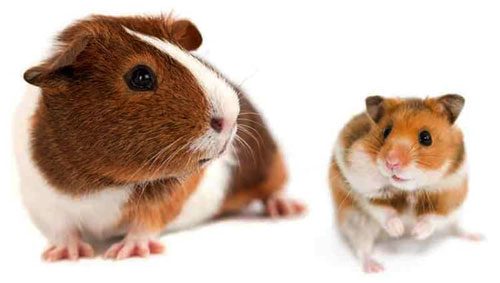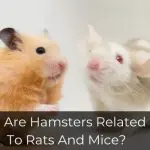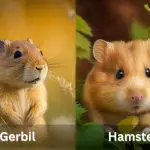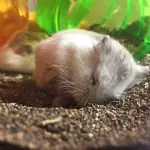Hamsters vs Guinea Pigs: Which Is Better For You?
The two most popular pets worldwide are guinea pigs and hamsters. They make great pets for people of all ages. When selecting a pet, it could be challenging to decide which of these two animals is a better fit for you.
So, among hamsters Vs Guinea pigs, which rodent is better for a household pet? This depends on several factors, such as size, space, dietary needs, lifespan and adaptation level.
In this article, we’ll highlight the key differences between hamsters and guinea pigs to help you decide. Stay tuned and read till the end.
A Complete Comparison Between Guinea Pigs And Hamsters
Hamsters are small, furry rodents that belong to the family Cricetidae. The most commonly kept pet hamsters are the Syrian hamster and the Dwarf hamster. Guinea pigs, also known as cavies, are a popular pet species due to their friendly nature and unique appearance.
Guinea pigs and hamsters are both common mammals kept as pets, yet they are fundamentally different from one another.

The detailed comparisons between hamsters and guinea pigs are listed in the table below-
| Hamster | Guinea Pig | |
|---|---|---|
| Size | The size of a well-grown hamster is about 6 to 8 inches long | The size of a guinea pig is about 8 to 10 inches long |
| Weight | Hamsters typically weigh 2 to 8 ounces | Guinea pigs typically weigh 1.5 to 2.5 pounds |
| Diet | Hamsters are omnivores | Guinea pigs are herbivores |
| Lifespan | Hamsters usually live for 2 to 3 years | Guinea pigs usually live for 5 to 7 years |
| Reproduction | Female hamsters can give birth to 12 pups per litter after a gestation period of 16 to 22 days | Female guinea pigs can give birth to four pups per litter after a 59 to 72 day gestation period |
| Behavior | Hamsters are solitary and nocturnal animals | Guinea pigs are energetic and social animals |
| Natural habitat | Hamsters prefer living in warm, dry environments | Guinea pigs prefer living in mountains and grasslands |
| Offspring | The offspring of hamsters are born hairless, blind, and deaf | Guinea pig babies are born with furry bodies, eyes, ears, and the ability to run |
| Senses | Hamsters have poor eyesight but excellent senses of smell and movement | Guinea pigs are dichromats and have enhanced hearing, smell, and touch senses |
The Differences Between Hamster And Guinea Pig
- Size– The average size of a Syrian hamster is between 6 and 8 inches, but the average size of a dwarf hamster is between 4 and 5 inches. Guinea pigs, on the other hand, are slightly larger, measuring 8 to 10 inches on average.
- Weight- The weight of hamsters and guinea pigs varies with breed and age, but a hamster typically weighs between 2 and 5 ounces. And Guinea pigs can weigh up to 2.5 pounds, with an average weight of about 1-2 pounds.
- Appearance- Hamsters are rodents with rounded, flexible bodies, strong hind legs, and round cheeks. Their thick, silky fur and wide eyes give them a unique appearance. The body shape of guinea pigs is more elongated, and their large size, expressive eyes, and long legs give them a more significant look.
- Diet- Although hamsters are omnivores, they can eat both meat and vegetables. They require a nutritious diet with a variety of seeds, fruits, and vegetables. Such as in the table below.

| Vegetables | Fruits | Fibre | Protein | Fat | Carbohydrate |
| Daily 1-2 teaspoon | Daily 1 teaspoon | Daily 10-15% | Daily 10-16% | Daily 4-5% | Daily less than 20% |
Due to their herbivorous nature, guinea pigs need a diet high in fiber and low in fat and sugar. Their diet should consist of hay, fresh vegetables, Vitamin C and food pellets, as the table represents below.

| Vegetables | Fibre | Protein | Fat | Carbohydrate | Vitamin C |
| Daily 15% | Daily 10-16% | Daily 18-20% | Daily 2-4% | Daily less than 10% | Daily 10-50mg |
- Lifespan- With the proper care, guinea pigs can live for five to seven years. Syrian hamsters, the most popular breed, live for 2 to 3 years, while Dwarf hamsters only survive for 1 to 2 years.
- Reproductive cycle- Female hamsters frequently give birth to up to 12 pups in a litter due to their short reproductive cycles and high breeding rates. Female hamsters can reproduce as early as six weeks after they reach sexual maturity.
Conversely, guinea pigs breed less frequently and have a longer reproductive cycle. In female guinea pigs, sexual maturity occurs when they are 4-6 months old. They can give birth to 1-4 pups per litter.
- Offspring-Hamster pups are born hairless and blind, but they can see and move about in a matter of days. Within two weeks of birth, hamster pups can eat solid food. They continue to nurse from their mothers up to 4-6 weeks before they are weaned.

The offspring of guinea pigs start moving around and feeding on solid food right after birth. They are born with open eyes and full fur. Puppies of guinea pigs will nurse from their mother for a few weeks, but they should also have access to fresh hay and water.
- Behavior- Guinea pigs can live together in the same cage because they are social animals. They are alert, lively animals who enjoy playing and roaming around. They are also noisy animals who communicate with their owners and one another by making a variety of noises.
Generally, hamsters prefer to live alone. Hamsters are nocturnal creatures and will spend most of the day sleeping in their cage. They also hoard, storing food and bedding in their cheeks to bring back to their nests.

- Natural Habitat- Guinea pigs originated from the Andes Mountains, Peru and Bolivia. They inhabit rocky areas, grasslands, and forests. Guinea pigs are social animals that live in groups in the wild. To ward off predators, they use their sharp fangs and excellent hearing.
Hamsters live in dry and steppe climate habitats. They dig a network of tunnels and chambers underground to find food, shelter, and protection.

- Senses- Hamsters have strong hearing and smelling senses, but their eyesight is poor. Hamsters use their sense of smell to find food and their sense of hearing to detect predators. Although guinea pigs have better hearing and vision compared to hamsters, their sense of smell is less developed.
- Health problems- Hamsters are prone to conditions like Wet Tail, respiratory infections, and tumors. Guinea pigs may suffer from health diseases like- scurvy, dental problems, lice infections and fungus infections.
Watch this YouTube video to learn more about the key distinctions between hamsters and guinea pigs before selecting your pet.
What Are The Different Maintenance Needs For A Hamster And A Guinea Pig?
It’s essential to understand the particular needs of guinea pigs and hamsters in order to give them the best care possible.

- Hamsters sleep during the day and are most active at night because they are nocturnal animals.
- Hamsters need a large and clean cage with lots of bedding material because they enjoy digging and tunneling.
- Guinea pigs are social animals and should live in groups with at least one other guinea pig.
- They also need a large cage with plenty of space to move around and explore.
- Guinea pigs enjoy playing and climbing, so you should provide them with toys and platforms to do so.
So, the maintenance should be undertaken according to the needs of each rodent.
When it comes to small pets, hamsters and guinea pigs are two of the most popular choices. However, if you’re a hamster owner, you may have noticed that your furry friend has a habit of biting their cage. If you’re wondering why this is happening, be sure to check out our article on why hamsters bite their cage. We explore the reasons behind this behavior and provide tips on how to stop it. Additionally, if you’re trying to decide between a gerbil or a hamster, check out our article on gerbils vs hamsters. We compare and contrast these two popular small pets to help you make an informed decision.FAQs
Read below these frequently asked questoins for further clarification on this matter.
Q: Which is simpler to take care of, a Hamster or a Guinea Pig?
Hamsters can stay in a small cage due to their small size. They might be less demanding to care for than guinea pigs because of their solitary nature. Additionally, hamsters are easier to maintain than guinea pigs because they are cleaner animals and are easy to train.
Q: Are Guinea pigs noisier than Hamsters?
Hamsters are frequently quieter than guinea pigs. During the night, hamsters are active and make squeaking sounds. Guinea pigs, on the other hand, are noisier and can make a variety of noises, such as whining, purring, and hooting. They can become rather loud.
Q: Are Guinea Pigs more smelly than Hamsters?
Since hamsters are small creatures, they are simple to care for. If their cage is kept clean and they get a bath every week, they don’t smell bad. Guinea pigs must be washed frequently or they will start stinking.
Bottom Line
In conclusion, both guinea pigs and hamsters may make wonderful home pets. Hamsters and guinea pigs differ significantly in terms of size, diet, behavior, odor level, lifespan, and natural environment, among other things.
So, it is important to give hamsters and guinea pigs a secure, hygienic, and warm habitat that suits their needs and enables them to live healthy life. As a pet owner, you should understand the basic differences between these two animals before making a decision on which creature to adopt as a pet.




